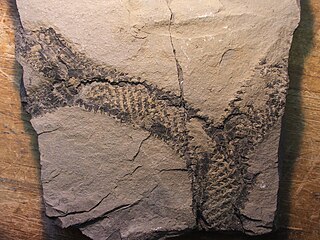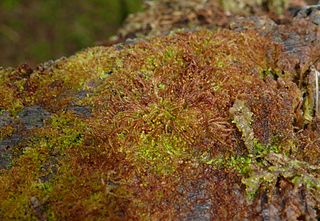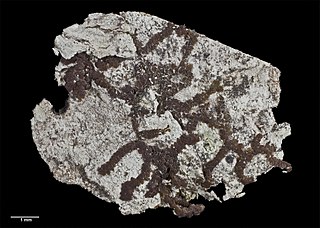
Caudalejeunea grolleana is a species of liverwort in the family Lejeuneaceae. It is an endangered species endemic to Madagascar.
Fulfordianthus evansii is a species of liverwort in the family Lejeuneaceae. It is found in Belize, Costa Rica, Guatemala, and Panama. Its natural habitat is subtropical or tropical moist lowland forests.
Haesselia roraimensis is a species of liverwort in the family Cephaloziaceae. It is endemic to Guyana. Its natural habitat is on rotten logs in periodically flooded riverine forest from 550 to 1,550 metres elevation, in the humid submontane tropical 'mossy' forests on the slopes of Mount Roraima, where the borders of Brazil, Venezuela, and Guyana meet.
Colura irrorata is a species of liverwort in family Lejeuneaceae. It is endemic to Ecuador. Its natural habitat is subtropical or tropical moist lowland forests. It is threatened by habitat loss. The species was previously known as Myriocolea irrorata, but was transferred to Colura in 2012 following a phylogenetic analysis of nuclear and plastid molecular markers and a reinterpretation of morphological characters.
Radula jonesii is a species of liverwort in the family Radulaceae, first described in 1988 from specimens collected in the Anaga Mountains of Tenerife. Endemic to Macaronesia, this dark to olive-green liverwort is known from five locations on Madeira Island and one location on Tenerife, where it grows as both an epiphyte on trees such as Laurus novocanariensis and as a lithophyte on shaded rocks in old growth laurel forest ecosystems between 800–1,000 m (2,600–3,300 ft) altitude. The species is distinguished by its procumbent growth habit, pinnately branched stems measuring 10–15 mm (0.4–0.6 in) in length, and distinctive cellular features including uniformly thin-walled leaf cells. Classified as Endangered due to its restricted range and small population size, R. jonesii faces threats from climate change, habitat degradation, and tourism pressure, though its habitat receives protection through various conservation designations including UNESCO World Heritage status.
Radula visianica is a species of liverwort in the family Radulaceae. It is endemic to the European Alps. It was thought to be extinct since 1938 but was rediscovered in 2014 in Austria.

Radula is a genus of liverwort in the family Radulaceae. The genus includes 248 species of small plants that typically grow as green, scaly patches on tree trunks, logs, or rocks in moist environments. It is distinguished from other liverworts by several unique features, including the production of root-like structures (rhizoids) exclusively from leaf surfaces and characteristic branching patterns. The plants have rounded, overlapping leaves consisting of two unequal lobes, with considerable variation in structure across species. Following a major taxonomic revision in 2022, the genus comprises five subgenera with distributions ranging from tropical to temperate regions. The oldest known fossil species, R. cretacea, found in Burmese amber, dates to the Cenomanian age, though molecular evidence suggests the genus originated in the Triassic period, around 228 million years ago.

Lepidodendrales or arborescent lycophytes are an extinct order of primitive, vascular, heterosporous, arborescent (tree-like) plants belonging to Lycopodiopsida. Members of Lepidodendrales are the best understood of the fossil lycopsids due to the vast diversity of Lepidodendrales specimens and the diversity in which they were preserved; the extensive distribution of Lepidodendrales specimens as well as their well-preservedness lends paleobotanists exceptionally detailed knowledge of the coal-swamp giants’ reproductive biology, vegetative development, and role in their paleoecosystem. The defining characteristics of the Lepidodendrales are their secondary xylem, extensive periderm development, three-zoned cortex, rootlike appendages known as stigmarian rootlets arranged in a spiralling pattern, and megasporangium each containing a single functional megaspore that germinates inside the sporangium. Many of these different plant organs have been assigned both generic and specific names as relatively few have been found organically attached to each other. Some specimens have been discovered which indicate heights of 40 and even 50 meters and diameters of over 2 meters at the base. The massive trunks of some species branched profusely, producing large crowns of leafy twigs; though some leaves were up to 1 meter long, most were much shorter, and when leaves dropped from branches their conspicuous leaf bases remained on the surface of branches. Strobili could be found at the tips of distal branches or in an area at the top of the main trunk. The underground organs of Lepidodendrales typically consisted of dichotomizing axes bearing helically arranged, lateral appendages serving an equivalent function to roots. Sometimes called "giant club mosses", they are believed to be more closely related to extant quillworts based on xylem, although fossil specimens of extinct Selaginellales from the Late Carboniferous also had secondary xylem.
This glossary of botanical terms is a list of definitions of terms and concepts relevant to botany and plants in general. Terms of plant morphology are included here as well as at the more specific Glossary of plant morphology and Glossary of leaf morphology. For other related terms, see Glossary of phytopathology, Glossary of lichen terms, and List of Latin and Greek words commonly used in systematic names.

Perrottetinene is a naturally occurring cannabinoid compound found in liverworts from the family Radulaceae native to Japan, New Zealand and Costa Rica, namely Cladoradula perrottetii, Radula marginata and Radula laxiramea, along with a number of similar compounds. Its chemical structure closely resembles that of THC, the main active component of marijuana but with a cis rather than trans conformation and a bibenzyl tailchain instead of pentyl. The absolute configuration of perrottetinene was established in 2008 by an enantioselective total synthesis.

Pleurozia is the only genus of liverworts in the family Pleuroziaceae, which is now classified in its own order Pleuroziales, but was previously included in a broader circumscription of the Jungermanniales. The genus includes twelve species, and as a whole is both physically distinctive and widely distributed.

Radulaceae is a family of liverworts, and the only family in the order Radulales. The family comprises three genera: Radula, Cladoradula, and Dactyloradula, recognised as distinct following a 2022 taxonomic revision. Distinguishing features include bilobed leaves arranged in two rows, with the smaller lobe folded under the larger one, and rhizoids uniquely emerging from leaves rather than stems. The family lacks underleaves, which are common in other liverwort families. Fossil evidence from Burmese amber indicates the family had diversified by the Cretaceous period, approximately 98 million years ago, with molecular studies suggesting its divergence from related groups occurred during the Permian period.

Ptilidium is a genus of liverwort, and is the only genus in family Ptilidiaceae. It includes only three species: Ptilidium californicum, Ptilidium ciliare, and Ptilidium pulcherrimum. The genus is distributed throughout the arctic and subarctic, with disjunct populations in New Zealand and Tierra del Fuego. Molecular analysis suggests that the genus has few close relatives and diverged from other leafy liverworts early in their evolution.

Lejeunea hodgsoniana is a species of liverwort in the family Lejeuneaceae. Endemic to New Zealand, it was first recognized in 1980 but not formally described until 2013. The plant forms bright green mats up to 7 centimetres in diameter on tree bark and occasionally on rocks. The species is found from the Kermadec Islands in the north to the Chatham Islands in the south, primarily in coastal and lowland areas below 100 metres elevation. It is distinguished from related species by its relatively large size, multi-celled tooth on the leaf lobule, and deeply divided underleaves with pointed tips. While showing a particular affinity for mahoe trees, it grows on various native and introduced trees and is considered "Not Threatened" under the New Zealand Threat Classification System due to its abundance within its range and ability to grow in both pristine and disturbed habitats.

Radula demissa is a species of liverwort in the family Radulaceae. It occurs in southeastern Australia and New Zealand, where it grows as an epiphyte in temperate rainforest environments.
Cladoradula perrottetii is a species of liverwort is the family Radulaceae. It is distributed across tropical and subtropical Southeast Asia, occurring in Thailand, Sumatra, Taiwan and Japan. It contains the small molecule perrottetinene, a cannabinoid, and other secondary metabolites of scientific interest including marchantin A.

Rhinonycteridae is a family of bats, within the suborder Yinpterochiroptera. The type species, the orange nose-leafed species group Rhinonicteris aurantia, is found across the north of Australia.

Nowellia curvifolia is a species of liverwort belonging to the family Cephaloziaceae. It is a small, delicate plant that forms prostrate growths on rotting logs in forests throughout the northern temperate and subarctic regions. The species is distinguished by its distinctive billowed leaves arranged in two rows, each divided into two pointed lobes with the lower lobe forming a specialised water-holding pocket called a water-sac. The plant shows seasonal colour variation from rose to purple to brown to spring green, developing reddish-purple pigmentation in autumn and winter. It reproduces both sexually, through spores produced in reddish-brown capsules, and asexually via single-celled gemmae. N. curvifolia serves as an indicator species in forest ecosystems, particularly in montane spruce-fir forests, where it often forms pure mats on decorticated logs and is associated with the slime mould species Barbeyella minutissima.

Frullania wairua, the spirit liverwort or radar bush liverwort, is a species of liverwort in the order Porellales. It is one of 24 species in the large genus Frullania that are native to New Zealand. The species was first described by Matt von Konrat and John E. Braggins in 2005 in the New Zealand Journal of Botany.
Cladoradula is a genus of liverworts in the family Radulaceae. Distinguished by its thick, brown-pigmented stems and distinctive branching pattern, it comprises seven species found primarily in tropical and temperate forest regions worldwide. Originally established as a subgenus of Radula in 1885, it was elevated to genus rank in 2022 following molecular studies that revealed it represents one of the oldest lineages within Radulaceae, having diverged during the late Permian period about 263 million years ago. The genus is characterised by its specialised stem structure, distinctive leaf arrangement, and small protective structures around its reproductive organs. Species in the genus grow on tree bark or shaded rocks from sea level to over 2,000 m (6,600 ft) in elevation.










